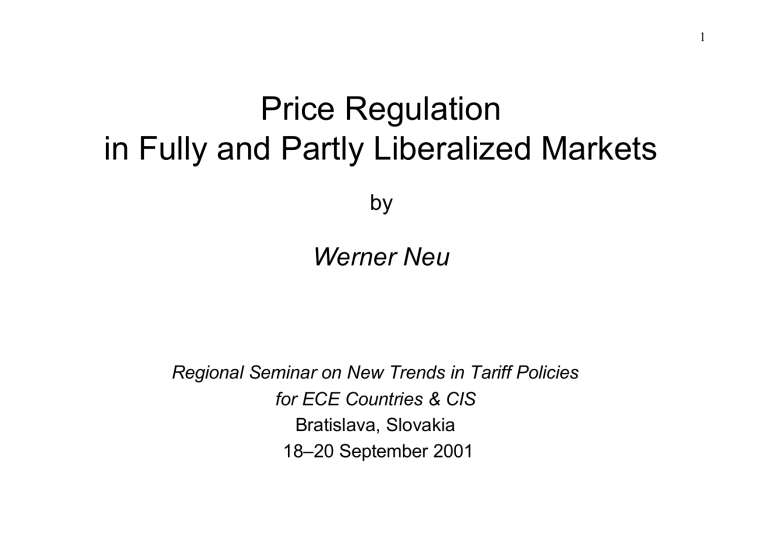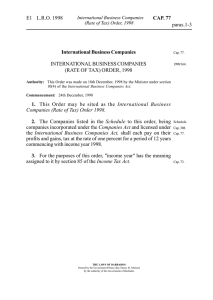Price Regulation in Fully and Partly Liberalized Markets Werner Neu by

Price Regulation in Fully and Partly Liberalized Markets
by
Werner Neu
1
Regional Seminar on New Trends in Tariff Policies for ECE Countries & CIS
Bratislava, Slovakia
18–20 September 2001
Contents
• Objectives of price regulation
• Areas of application
• Different approaches
• Discretionary price setting
• Price setting for particular services based on costs
• Price cap regulation
• Particular issues of price regulation
• Summary
2
Objectives of price regulation
• Financing objectives
Regulated operators must be permitted to earn sufficient revenue
• Efficiency objectives
Allocative efficiency
Productive efficiency
Dynamic efficiency
• Equity objectives
Operator-consumer equity
Consumer-consumer equity
Operator-operator equity
3
Areas of application
• Prices for end-users
Approach and intensity of regulation depends on degree of effective competition
• Prices for intermediate products
(interconnection, leased lines)
Regulation will be necessary for quite some time to come
4
Different approaches
• Discretionary price setting
Typical for former monopoly situation
• Price setting for particular services based on costs
(rate of return regulation)
Currently widely used for prices of interconnection services (also in fully liberalized markets)
• Price cap regulation
Currently widely used for prices of end-user services
5
Discretionary price setting
• Disadvantages :
Interventionist
Lack of economic criteria
Inefficient price structures
Risk that financial objective for operator is not fulfilled
6
Discretionary price setting
• Typical results:
Low access and local calling prices
High prices for long-distance calls
Very high prices for international calls
• As result of low access prices, no incentives for operator to roll out network
Long waiting lists
low quality in access network
7
Price setting for particular services based on costs
• In contrast to discretionary price setting, explicitly based on economic criteria
• Used to be dominant mode of regulation in USA
• Currently mostly applied to new services, in particular interconnection services
• High demands in terms of data requirements
• Top-down approach on the basis of data provided by regulated firm
• Bottom-up approach on the basis of analytical cost models
8
Price setting for particular services based on costs
• Issues related to top-down approach:
Departs from cost data of operator
Question whether cost data reflect an efficient operation
Cost elements not caused by regulated service need to be eliminated
9
Price setting for particular services based on costs
• Issues related to bottom-up approach:
Relevant technology must be known so that it can be implemented in a cost model
Parameters for cost modelling (prices of investment goods, average usage patterns, etc.) must be known
While feasible for cost of investment, modelling of cost of operations still problematic
10
Price setting for particular services based on costs
• Disadvantages if applied to end-user services on a broad basis (makes no sense if there is competition):
Lack of incentive to minimize costs
Lack of innovation
Lack of pricing flexibility
Costly in terms of regulatory and management attention
• Above less of a problem regarding interconnection services
11
Price cap regulation
• Goes back to Prof. Littlechild of the UK
• First used to regulate BT’s retail prices, starting 1984
• Now most widely used approach to regulate retail prices for end-users
• Was introduced to mitigate disadvantages of regulation based on costs
• Approach to be used before price finding can be entirely left to the market
12
Price cap regulation
• Basic price cap formula: allowable price for upcoming period
= starting price + I – X where I = inflation factor for the period
X = productivity factor
13
Price cap regulation
• Example:
At end of 2001 price = 100
Projected I = 5 and X =3
=> Allowable price change for 2002 = 2 or
=> Allowable price for 2002 = 102
• In real applications, weighted average over price changes for relevant basket of services
Price change of 2 above would equal that weighted average
14
Price cap regulation
• Required inputs:
Initial prices for services in relevant basket
Weights (usually services’ shares in turnover
Inflation factor)
Productivity factor
Design of baskets (which services to be included, which services grouped in same basket?)
15
Price cap regulation
• Advantages:
Incentives for greater efficiency
Greater pricing flexibility
Reduces regulatory intervention
• Disadvantages:
Does not have a mechanism to prevent anticompetitive pricing
If values for I and X are wrong, can miss objectives (financing, efficiency, equity) very badly
16
Particular issues of price regulation
• Rebalancing of prices according to actual costs
• Need for pricing options which make for efficient use of network
• Need for self-select pricing packages which make services affordable for low income earners
17
Summary
• Discretionary price setting an thing of the past
• Price setting for particular services based on cost necessary for interconnection etc.
• Price cap regulation suitable approach for retail services – as long as competition not strong enough
• Promote tariff structure that enhances efficient use of the network and makes services affordable also for low users
18



